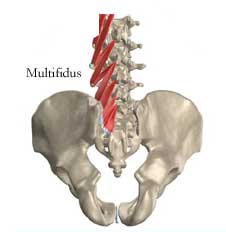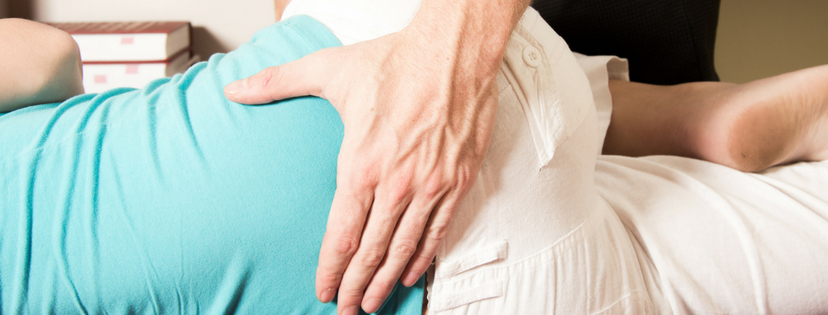In this article
To the everyday person, our back seems relatively simple – made up of our spine, our spinal cord which helps us move and a heap of muscles which can cause us pain.
But, it’s a lot more complicated than you might think. In fact, there are over 40 muscles, tendons, cartilage and bones making up one of our most vital parts of the body. [1]
One of those muscles, which does a lot of unsung work, but can cause us pain is the multifidus muscle.
In this month’s blog, we investigate how to keep this unassuming, but very important, muscle strong and explain how to identify whether it’s the cause of your back pain.
What is the multifidus
The multifidus muscle is a long, narrow muscle which runs on either side of the spinal column. For most people it starts in the middle of the ribs and runs down to the tailbone.
The multifidus muscle supports our back in several ways, but its main role is to stabilise the lower portion of our spine, better known as the lumbar spine. We also use it when we stretch or reach for something above our heads. [1]

Image sourced from Google Images.
Symptoms of a multifidus muscle issue
If you are not regularly using and strengthening your multifidus muscle it can become weakened and cause lower back and core issues.
Some symptoms to look out for are:
- Tightness
- Instability of the spine
- Herniated discs (bulging/slipped disks)
- Pinched nerves
- Poor posture
- Osteoarthritis
- Osteophytes
If you have any of these symptoms, book an appointment with a physio to assess your back strength and movement of the spine.
How multifidus weakness can cause back pain
For such an unknown muscle, the multifidus does a heap of work, and when it’s not at its best, it can cause back pain.
When your lumbar multifidus muscle is weakened, it isn’t stabilising your spine as it should. This can cause strains to other muscles and pain in the lower back and spine due to incorrect movements, injuries and other muscles compensating for the weakness. [1]
Working with a physiotherapist is an easy way to maintain the strength of your multifidus muscle. Through manual treatments, stretching and exercise, you can maintain and strengthen your multifidus and keep your lumbar spine in great shape.
Multifidus exercises for strengthening
Here are some exercises you can do at home to strengthen your multifidus muscle. For one, you’ll need a dumbbell, but if you don’t have one, opt for a can from the pantry or complete the movement without the weights.
Side plank
Lie on your side with your elbow directly beneath your shoulders with your legs stacked. Lift your hips off the ground, creating a straight line from your lead to your feet. Hold for 20-30 seconds. Complete ten times. Switch sides and repeat.
One-arm row
Using a weights bench or a table, place one leg back into a straighten position and lean forwards from your waist until your upper body is parallel to the floor. Place your hand on the bench for support.
Pick up a dumbbell from the floor with the unused hand and hold the weight with a straight back. Pull the dumbbell straight up to the side of your chest and keep your torso still. Lower the weight down to the starting position. Repeat 10 times and then swap arms.
Bird dog
Get onto your hands and knees. Make sure your hands are directly under your shoulders and your knees are under your hips. Engage your glutes and abdominals to extend your left arm and right leg out at the same time. Hold this for 10 seconds then return to the starting position and swap to a right arm, left leg extension.
How can The Brisbane Spine Clinic help
If our name isn’t a giveaway, we are interested in all aspects of spine strength and physiotherapy. Our team can work with you to assess your spinal health, make recommendations to strengthen muscles to reduce pain and treat any acute pain points, all in one session.
Because, while your multifidus muscle isn’t well known, it plays a vital role in your spinal health and mobility.
Book an appointment with one of your qualified team here – multifidus back pain shouldn’t be part of your day-to-day.
Multifidus degeneration is often overlooked but once identified, we can categorise the severity of the problem and determine how to deal with it. Our goal is to give you the best chance to recover and rehabilitate.
If you are dealing with back pain, call us at 07 3841 3070 or book an appointment online for one of our Spine Special Consults, and we can help identify the true cause of your back pain and the steps required to treat it.
DISCLAIMER FOR HEALTHCARE EDUCATION
All information is general and is not intended to be a substitute for professional medical advice. The Brisbane Spine Clinic can consult with you to confirm if this treatment is right for you.
Sources, links and date of access. Scientific references only required for large medical device or if specifically requested.
References
[1] Healthdirect, Lumbar Spine, accessed online 8 December 2024, https://www.healthdirect.gov.au/lumbar-spine
Compliance Information
In Australia, healthcare advertising is regulated by AHPRA (practitioners and services) and the TGA (therapeutic goods and medical devices). Specific restrictions apply to advertising medicinal cannabis products.
We seek to provide you with compliant copy but remind you that compliance remains your responsibility. We ask that you review this copy carefully to check that you have met your compliance obligations. That includes checking any links or references provided. We aim to verify claims by citing reputable sources such as studies, professional groups or major health organisations and charities. Please ensure you are happy with the sources used to verify claims made in your copy (if not, please provide an alternative source).







